

Our starting position:
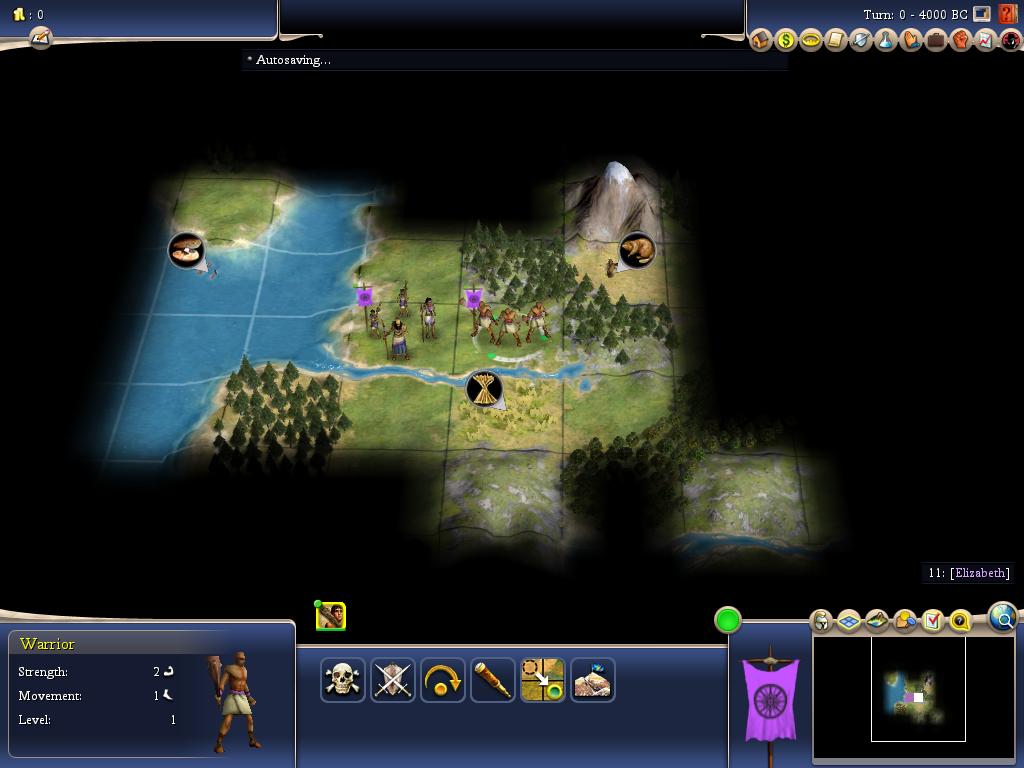
We had an immediate decision to make, whether to found in place with the wheat/clams/fur start, or move inland towards the fog in the hopes of finding more food resources. My thought was to stay in place, since we did have double food bonuses and there was no guarantee that we'd find anything by moving blindly. Coastal capitals do offer a number of benefits (early access to ships, Colossus/Great Lighthouse, coastal trade routes, etc.) although they are also inherently more vulnerable to attack. Speaker wanted us to move the settler, pointing out that we didn't start with Fishing tech (no early work boats without researching a fairly useless tech) and that there were only four forests present for chopping along the coast. Playing as India, getting some early Fast Workers out and chopping forests can be one of the most powerful starting tactics possible - assuming you don't get attacked!
We went back and forth on this for a little bit. When moving the warrior found a second river located to the southeast, with a number of grassland forests present, Speaker was convinced that a capital in that area would be superior even if there were no food bonuses present, solely due to the power of chopping:
Speaker:|
One thing I noticed was that the hill tile 1S of the wheat *is* on fresh water. Moving there picks up a whopping 5 river tiles, so far as I can tell, and has at least 6 forests. There are 5 tiles which could possibly have another food, but that's not my major impetus for suggesting we move. While those coastal trade routes are impressive in a theoretical sense, it will take a *long* time for them to grow to that point, and spending lots of turns working non-growing coastal tiles in the capital pains me, when we could be developing cottages into towns instead. We would have *6* coastal tiles in the capital. We could easily plant our second city on the coast for the clams, bang out a lighthouse and Moai statues, and have two powerhouse production cities. Free-Speech, river towns in Universal Suffrage with a Levee are probably the most powerful tiles in the game, and we'd gain a lot of those in our capital by moving. |
Moving the settler is not something I would do here, but Speaker had played vastly more MP early-game openings than I have, and I deferred to his judgment. Well, fortunately for us we got to have our cake and eat it too:

Jackpot!  Not only did we get a riverside location, with no fewer than five grassland river tiles for cottages, we also landed double food bonuses (irrigated wheat + grassland cows) for a total of +7 food surplus. Add in five grassland hills for excellent production and EIGHT choppable forests in the starting 21-tile radius, and we had a dream of a capital location. The capital was founded on Turn 1 (the first turn being Turn 0), and named "Gettysburg" to fit with our planned Civil War battles naming theme:
Not only did we get a riverside location, with no fewer than five grassland river tiles for cottages, we also landed double food bonuses (irrigated wheat + grassland cows) for a total of +7 food surplus. Add in five grassland hills for excellent production and EIGHT choppable forests in the starting 21-tile radius, and we had a dream of a capital location. The capital was founded on Turn 1 (the first turn being Turn 0), and named "Gettysburg" to fit with our planned Civil War battles naming theme:

Production into a Fast Worker (15 turns), research into Bronze Working tech (14 turns). Speaker and I had decided before the game even began that we would play a low-defense gambit in the early stages. The plan was to start with a Fast Worker and research Bronze Working, then use the new tech to chop out a second worker while researching Agriculture and then Animal Husbandry. Once we had two workers, they could quickly improve both food resources and then double-chop a settler at size 2 by cutting four more forests. If everything worked as planned, we would have an explosively strong start from a growth perspective. Outside of Joao's Expansive/Imperialistic trait combo (not present in this game), no one can grow as fast a chop-infused Fast Worker rush. If everything didn't work as planned, and another team happened to start nearby and rush us immediately, the game would be lost before it ever really began. It was a gambit, one we were fine with taking. We had no desire to spend months playing this game as an also-ran. Better to risk for big gain right at the start.
Not much happened for the first few turns. Gettysburg was stuck at size 1 building a worker, and would be for quite some time to come. All of the other teams settled in the starting spot on Turn 0, except for LiPing's Rome, who moved for two turns before settling (which would have major consequences later). We moved our warrior in a circle around our starting location, keeping him nearby the capital but still traveling enough to reveal the local neighborhood. The terrain we did find was really good stuff, almost entirely grassland with plenty of food resources and rivers winding across the landscape. With a mere five turns of scouting information underway, I went ahead and took a guess at the underlying map script:
Sullla:|
I was thinking about which map script this could be, and my best guess at the moment is the Donut script. There's some very good evidence to suggest this: |
This did turn out to be the correct guess, although the mapmaking team had done a great job and mixed in some unusual features that we wouldn't discover until later on. Having some idea of what the map looked like, even a rough sense, definitely helped us make informed decisions in the early going.
We knew that the other teams would be pretty close to us, and sure enough, CONTACT on Turn 8! 

|
Meet the Jowy/Yaz team. Here is our dossier on their team: |
I had an Excel file tracking the other teams in the early going, monitoring score increases, population, techs, and soldier count (power rating). I had plenty of experience in this from the Apolyton Demogame, and with little taking place during the opening turns, it was something that helped passed the time and make the game interesting. You can pull some very useful stuff from those numbers. Anyway, we thought we were fortunate to have Jowy as our northern neighbor. Because Greece had the scout start mentioned by Speaker on the previous page, we didn't have to worry about an early rush on our capital. Jowy didn't appear to be one of the "big names" in this game, and thus less likely to be feared. We hoped we could establish friendly relations and simply outgrow his empire over time.
I won't bother to post the first few diplomatic exchanges, which were the standard pleasantries. We agreed with Jowy to exchange information on any other teams that we each happened to meet, which was sort of a good deal for us because he had a scout and we had a warrior opening. Jowy also asked us not to plant any aggressive "Pink Dot" cities between our teams. (Ha! Too many people read my Apolyton writeup, it seems.) We were fine with agreeing to that, since we had no need and no plans for far-off cities like Pink Dot. Beyond that, there wasn't too much that our teams could do so early in the game!
Then on Turn 13, the shocker: Mortius has been elimiated from the game! 


We saw the result on CivStats, although I've pulled the pictures above from one of the other spoiler threads because they look much better. The culprit was the Incan team of IamJohn, Kodii, and Zeviz (known as IKZ for short). They had the fortune to walk into an undefended capital while Mortius was building a worker, and that was it! (Remember what Speaker said about those scout starts? Heh.) I don't blame IKZ in the least for taking advantage of the situation, removing their Aggressive Zulu neighbor from the game at no cost to themselves. The Incans would therefore have a lot of empty space to expand into, which could pose problems for us down the road...
As for poor Mortius, his game was over before it even began. That was very unfortunate for the person who had organized this game in the first place! Due to the name involved (Mortius = Death), a warrior walking into an undefended capital has become known as "pulling a Mortius" in the Realms Beyond community since. Sorry Mortius, but it makes all too much sense. We followed the exact same strategy at the start, worker first, and simply didn't get called on it by any other teams. Pure luck, plain and simple. Poor Mortius.
Back in Indian territory, we were doing some planning for the initial workers:

|
Bronze Working research finishes on T15 |
That post does a good job of explaining why the Fast Worker is the most powerful unique unit in the whole game. The ability to move onto a forest and start chopping immediately makes such an enormous difference. We would produce the second worker in 6t instead of 8t as a result, and then both Fast Workers would allow us to improve the food resources 2t faster, which allowed Gettysburg to grow to the next size earlier, and so on. Speaker said it best before: Civ is a snowball game, and the Fast Worker gets the ball moving sooner and faster.
Speaker favored this location for our second city:

|
And just like that, our 2nd city was plotted. |
I had some thoughts of pushing out further east to claim the gold resource we had spotted over there, but Speaker wisely pointed out that such a location would be difficult to defend, and would require tons of worker labor to improve. Far better to expand closer to home first, only four tiles away, in a safe location with excellent land that could pass tiles back and forth with the capital if needed. Plus, the "red dot" location above would also secure copper for us! We decided to move forward under the assumption of settling this location first.
We also discovered our southern neighbor at this point:

|
Greetings Sullker, |
What an odd greeting, although I think Dantski was just copying the introduction text that the AI sends you on meeting. Thus Dantski of Romali (his name for the Caesar/Mali combination) would turn out to be our neighbor to the south. We had pegged Dantski as having the worst leader/civ combination in the game, so this was also good news for us, although having an Imperialistic team next door was a bit of a drag. We realized that we were a little bit closer to Dantski than we were intended to be, having moved the settler south on the opening turn. That could make for some tight space in the days ahead.
There was some concern that Dantski might walk into our undefended capital, with our warrior a fair distance away. However, we counted out the tiles and it actually was possible to return our warrior to Gettysburg before Dantski's unit could attack (since Dantski moved south on the following turn). Furthermore, at any point in time we could divert one of the worker forest chops into an emergency warrior if necessary, so this wasn't as dangerous as it might look. In fact, Dantski would explore up to our borders and then turn around and walk in the other direction without any issue of hostilities. Good news. As far as the early diplomacy, we exchanged some greetings and that was mostly it. Dantski wasn't very talkative when it came to email contact, a trait which would continue throughout the game. We just wanted to expand in peace for the moment, without making any binding commitments for the long term.
Dantski did tell us that the DMOC/Nakor Holy Rome team was located to his south, which allowed us to draw up an early world map guess:
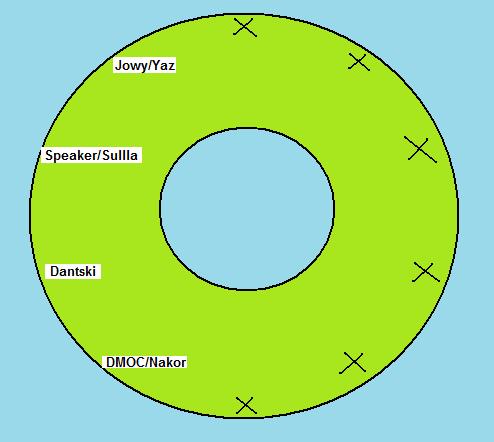
I was pretty confident that the world looked more or less like this. We had scouted far enough east to know that the center of the Donut had water present (which is one of the possible settings for that map script). We also knew that there were some offshore islands, although little more than that because we had moved off the coast. The biggest question at this point was which teams were located where around the rim of the Donut's edge.
Here was Speaker's dotmap for the early game:
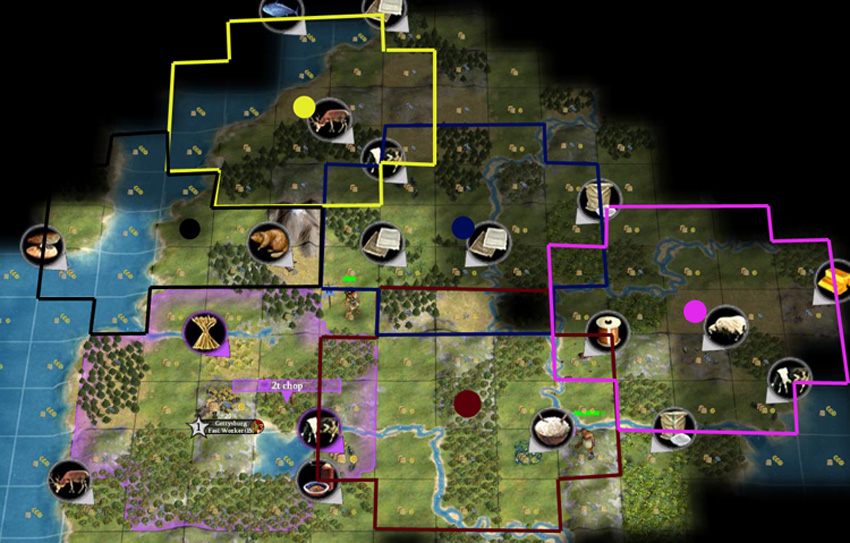
|
Gettysburg: For the immediate future, we'll want to concentrate on food and production here to get out another worker, and probably a second settler after the current one. (Whether to build these manually or whip is something we'll discuss as we go.) But outside of the immediate future, our goal with the capital should be to concentrate on commerce. That means working cottages over everything else, growing to the happy cap and then sitting there working all cottages (plus the wheat resource) while probably building a stream of workers. We have four riverside grassland tiles to add cottages to, all of which we can work in the early game, and we can add another six grassland cottages after that, which all adds up to some serious $$$. With the furs and gold resources, we get to size 7 in the capital even without Hereditary Rule, and we can work six cottages there, four of them riverside. Very powerful stuff! |
The priority order was Red, Blue, Pink - then Yellow and Black later on. These cities would mutually support one another from a defensive perspective, all had at least one food bonus if not two, and possessed many yummy grassland river tiles for Financial cottages. If we could land these cities quickly to form our civ's core, we figured to be in pretty good shape.
We soon opened up the Demographics charts with Jowy via passive espionage, and with only one city for each team, that allowed us to work backwards from the graphs and figure out what he had been doing. Skipping a whole bunch of boring numbers, suffice to say that Jowy had started out by growing to size 2, slow-building a work boat at 1 shield/turn, then at size 2 he went over to max shields and completed the build on T13. Then Jowy grew to size 3 while building a warrior, and only then finally started a worker on T19. (Our capital was only size 1, but we would have two workers on T22!) This shows again the weakness of the scout start, as Jowy had no military at all and felt compelled to build the early warrior. This kept Jowy safe, but definitely slowed down his opening. When you're Expansive, get that worker out ASAP!
"The Plan" continued to proceed nicely:
|
(T15) Agriculture 8t, Gettysburg 0/22 food, Fast Worker 56/60 (T16) Agriculture 7t, Gettysburg 0/22 food, Fast Worker 0/60 [Worker #1 done], Worker #1 move 1E and chop (3t) (T17) Agriculture 6t, Gettysburg 0/22 food, Fast Worker 4/60, Worker #1 chop (2t) (T18) Agriculture 5t, Gettysburg 0/22 food, Fast Worker 28/60, Worker #1 move 1NE and chop (3t) (T19) Agriculture 4t, Gettysburg 0/22 food, Fast Worker 32/60, Worker #1 chop (2t) (T20) Agriculture 3t, Gettysburg 0/22 food, Fast Worker 36/60, Worker #1 chop (done) (T21) Agriculture 2t, Gettysburg 0/22 food, Fast Worker 64/60, Worker #1 move 1SW and chop (done) (T22) Agriculture 1t, Gettysburg 0/22 food, Warrior 4/15 [Worker #2 done], Worker #1 move 1E and busywork mine (4t), Worker #2 move 1SW and prechop (3t) (T23) AH 12t, Gettysburg 3/22 food, Warrior 5/15, Worker #1 farm wheat (5t), Worker #2 farm wheat (4t) (T24) AH 11t, Gettysburg 6/22 food, Warrior 6/15, Worker #1 farm wheat (3t), Worker #2 farm wheat (2t) (T25) AH 10t, Gettysburg 9/22 food, Warrior 7/15, Worker #1 farm wheat (done), Worker #2 move 1NE onto forested hill (T26) AH 9t, Gettysburg 14/22 food, Warrior 9/15, Worker #1 move S-SW onto forest, Worker #2 chop (3t) (T27) AH 8t, Gettysburg 19/22 food, Warrior 11/15, Worker #1 chop (2t), Worker #2 chop (2t) (T28) AH 7t, Gettysburg 2/24 food [SIZE 2], Settler 40/100 [Warrior 13/15], Worker #1 chop (done), Worker #2 chop (done) (T29) AH 6t, Gettysburg 2/24 food, Warrior 13/15 [Settler 48/100], Worker #1 move 1E busywork mine (4t), Worker #2 move S-S-SE (T29) AH 5t, Gettysburg 8/24 food, Settler 48/100 [Warrior #2 done], Worker #1 move 1S and chop (3t), Worker #2 move 1SW and chop (3t) (T30) AH 4t, Gettysburg 8/24 food, Settler 56/100, Worker #1 chop (2t), Worker #2 chop (2t) (T31) AH 3t, Gettysburg 8/24 food, Settler 104/100, Worker #1 chop (done), Worker #2 chop (done) (T32) AH 2t, Gettysburg 8/24 food, Warrior 12/15 [Settler done], Worker #1 move 1N and mine (3t), Worker #2 move 1NW and mine (2t) (T33) AH 1t, Gettysburg 14/24 food, Warrior 14/15, Worker #1 mine (done), Worker #2 chills (no work to be done) (T34) AH complete, Gettysburg 20/24 food, Warrior 1/15 [Warrior done], workers move to cows and pasture (2t together) (T35) Gettysburg size 3, cattle pasture done, city #2 founded |
The advantage of planning out all the moves like this is that you can minimize waste, and ensure that your workers are optimizing their actions when they count most in the opening turns. The downside is that you can get too locked into "The Plan" and end up with a sense of tunnel vision, unwilling to adapt rapidly to changing circumstances. I'd say that this kind of microing is really only useful for about the first 50-75 turns of the game (Normal speed). Beyond that, there's simply too much going on, and the advantage of planning your moves drops off sharply compared to the time investment required. For the first 35 turns, however, it was unquestionably a boon.
Diplomatically, we were able to secure Non-Aggression Pacts (NAPs) with both of our neighbors. We agreed with Jowy on an NAP until T35, at which point in time it would renew to T75 if neither party objected. Dantski agreed on an NAP until 1000BC (T75), which we could discuss renewing starting on T65. This was perfect news for Speaker and me, letting us run a skeleton defense force and continue expanding as quickly as possible. The only really dangerous moves at this early point would have been a chariot rush or a dedicated skirmisher choke from Dantski, neither of which were in the cards for this game. We were criticized by some teams and lurkers later for lacking much military in the early game, but what they forgot was that we secured NAPs with both neighbors - we were pretty safe. And in fact, many of the other teams were also running pseudo farmer gambits themselves. We just happened to be much, much better at expanding than the other teams. 
Lumberjacks at work:
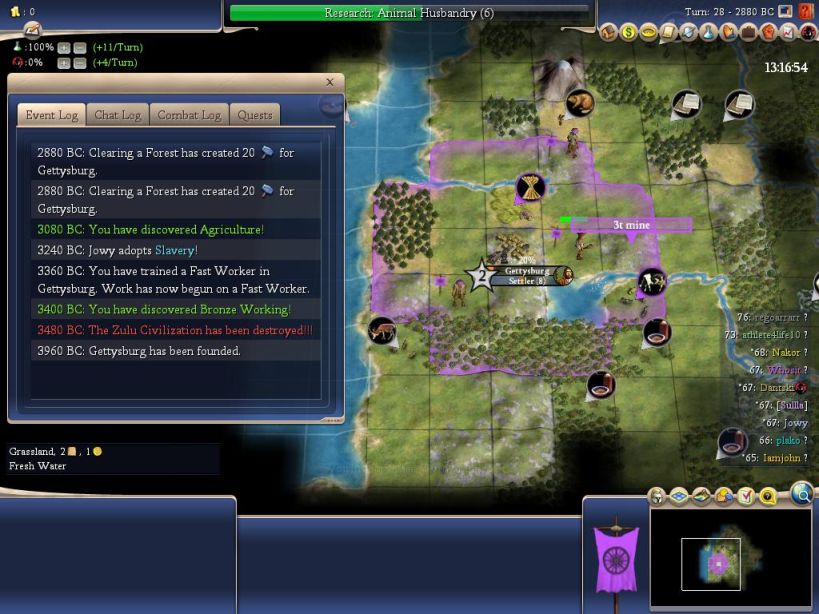
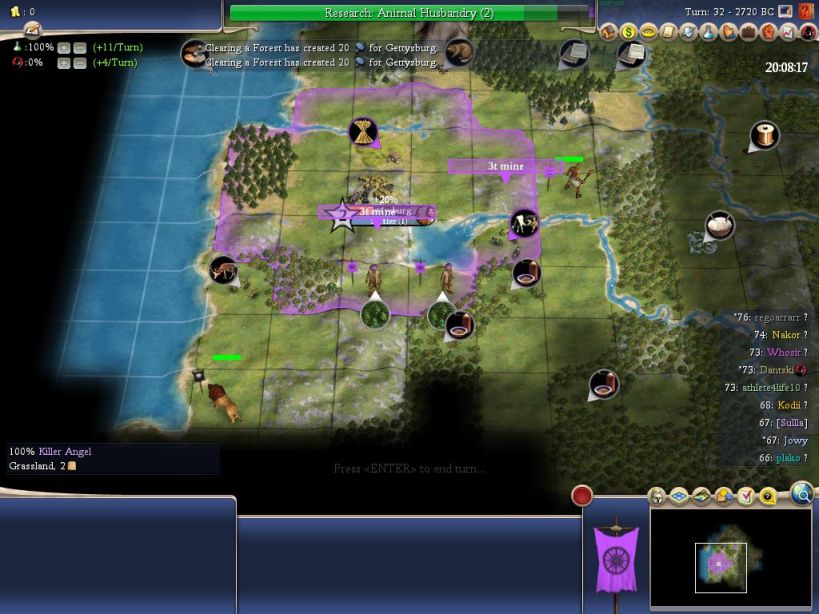
It may have been missed in all the text posted above, but we were essentially building a settler in 6 turns while also growing to size 2 and training a second warrior! Of course, that's because we were landing 80 free shields from four forest chops. And all that while waiting for Animal Husbandry research to come in so that we could hook up our second food bonus, no less. The ability to grow working food bonuses, and then swap to settler for one turn as the forest chops come in, has to be one of the best micro tricks you can pull in the early game. It lets you get around one of the fundamental tradeoffs in the game, the inability to grow cities and build workers/settlers at the same time. Love those Fast Worker lumberjacks!
Our second city of Antietam was founded on T35, as planned:

At this point, we had two cities, two workers, three warriors, and two improved food bonus tiles. We were the first team in the game to found a second city, and as best I can tell from reading the other spoiler threads now after the game's conclusion, we were the only team with two workers. (Remember, most everyone else started on the coast and went for a work boat at some point.) Jowy had the misfortune to lose a scout and his first warrior to barbarians, and had to slow his development further to train replacement warriors. Dantski had teched Hunting and Archery, and was training a few skirmishers for some reason. (Impregnable defense in cities, but a slow start from a growth perspective.) We had Bronze Working and Animal Husbandry techs, with both copper and horses visibile and in range of our current cities. Our two neighbors were friendly and showing no intention of acting aggressively towards us.
In short, things had gone about as well as they possibly could have up to this point. Unlike the Apolyton Demogame, where a crippled start put our team behind the eight ball from the beginning, with this excellent map Speaker and I looked to take a leading position very early on. Next up, we looked to continue expanding while starting to put some emphasis on research for the first time.



